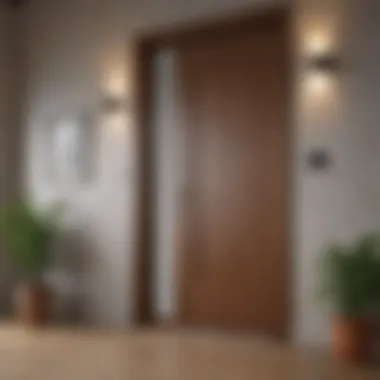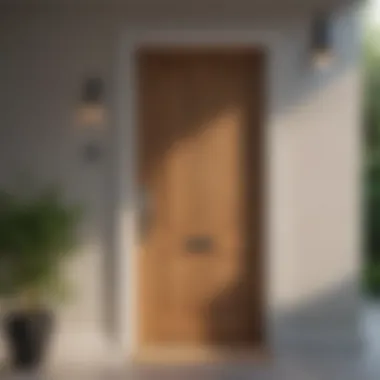Cost Factors for Installing a Door in an Existing Wall


Intro
Installing a door in an existing wall might seem like a simple weekend project, but don’t let that fool you; it often involves a maze of costs tied to various factors. Homeowners and professionals alike must navigate this landscape, balancing aesthetics with functionality and budget needs. This article aims to unearthing the layers of expenses that can pile up when you decide to pop in a door.
Cost considerations go beyond just picking materials and paying a contractor. A door can be that hinge—a pun intended—between spaces, offering not just access but also style and security. Whether you're planning to breathe new life into a dull area with a fresh, trendy design or ensure powerful functionality in a busy household, understanding what drives costs is vital.
Moreover, with interior design trends evolving faster than a puppy on a sugar rush, making informed choices can save a chunk of change without compromising on that modern look you crave. The goal here is to clarify and shine a spotlight on each cost component, ensuring you’ll be equipped to make decisions that don’t just look good but also fit your wallet.
Design Inspiration
When contemplating the installation of a door, consider how it fits into the larger design narrative of your home. A door isn't merely an entryway; it can serve as an artistic feature. Here’s where design inspiration kicks in.
Current Trends in Interior Design
As homeowners increasingly seek the blend of form and function, here are some prevalent trends:
- Minimalism: A sleek, simple door can seamlessly integrate into a contemporary space without shouting for attention. Think streamlined wood doors with clean lines.
- Bold Colors: Doors painted in unexpected colors can create focal points. Picture a bright teal or rich emerald door in a neutral corridor that draws the eye.
- Mixed Materials: A door that combines wood with glass or metal accents can offer a modern twist, enhancing visual interest and appeal.
Knowing current mapping trends helps budget for any additional finishing touches that might be desired for bringing together your overall design vision. Is it a traditional charm you’re after, or are you looking for a more modern edge? Your choice of door can make all the difference.
Color Schemes and Palette Ideas
Choosing the right color scheme for your door will also influence cost. Here are some thoughts:
- Neutral Palette: Shades like beige or gray are generally cost-effective and match easily with various home decor styles.
- Bright Colors: While these can add personality, they often require specialized techniques or finishes, which can up the price.
- Contrast: A door that stands in stark contrast to its surroundings can draw attention, but remember, that can sometimes come at a higher cost, especially for custom-painted or designed doors.
A well-balanced design should reflect both personal style and budgetary wisdom.
Ultimately, the inspiration for your project should align with your lifestyle and the existing elements within your home, guiding you towards choices that encapsulate both beauty and practicality.
Prelude to Door Installation Costs
Installing a door in an existing wall might seem like a straightforward task, but it carries with it a bundle of complexities that often catch homeowners off guard. Understanding these costs can mean the difference between a well-planned renovation and a budget-busting surprise. This section serves as an essential outline for anyone considering this endeavor. It invites readers to think critically about the hidden factors that can alter total expenses.
Being informed about the expenses tied to door installation not only helps with financial planning but also prepares you for potential challenges. It’s about more than just slapping a door frame into a hole; there are structural factors, material choices, and labor nuances that can all play significant roles.
Additionally, taking into account the broader implications of installation costs enables homeowners to allocate their budgets more effectively and minimize unexpected hitches down the road. As the old saying goes,
"A stitch in time saves nine."
This rings particularly true in the context of home improvement projects. Planning ahead is key to keeping costs manageable and outcomes satisfying.
Understanding the Scope of the Project
Before diving into the nuts and bolts of door installation costs, one must assess the scope of the project. When talking about doors, it isn’t just about picking a door and slapping it into a wall. Various elements factor into this adventure. First off, homeowners should evaluate the wall's structure. Is it load-bearing or just a non-load-bearing partition? The answer can massively sway costs, as modifying a load-bearing wall often requires professional intervention.
Another layer involves existing conditions, such as whether there’s any damage to the wall, or if it’s conveniently located near utilities like wiring or plumbing. Taking stock of these factors early on provides clarity and ensures that plans match reality. Here are some quick tips to get started on examining the project’s scope:
- Identify wall type: Determine if your wall is load-bearing or not.
- Check utilities: Look out for any nearby electrical or plumbing lines.
- Assess the condition: Note any repairs needed in the vicinity of the installation.
Clearly laying out these considerations from the get-go assists in formulating a more realistic picture of the project.
Why Install a Door in an Existing Wall?
The motivation behind installing a door can vary from purely functional to stylish or even a bit of both. For instance, a homeowner may wish to create a dedicated office space at home. In this case, installing a door would enhance privacy, making the area more conducive to work without distractions. This simple change can transform an entire room's utility. It’s one of those win-win scenarios where function meets design.


Conversely, sometimes it’s about improving access. Maybe you're looking to connect a living room to an outdoor patio. Introducing a door here could facilitate a seamless transition between indoor and outdoor spaces. This not only enhances usability but can also add aesthetic value to a property.
Additionally, let’s not forget energy efficiency. A new, high-quality door can serve as a barrier against the elements, effectively cutting down on heating and cooling costs over time. Also, don’t overlook the chance to up the home’s resale value. A well-placed door can significantly improve the overall appeal of your home.
Anyone contemplating this endeavor should consider the benefits among the cost factors. Just remember, a meticulously planned door installation project can yield positive results that go well beyond the initial cash outlay.
Key Factors Affecting Installation Costs
Understanding the cost dynamics behind installing a door in an existing wall varies greatly based on several factors. Not just the price of the door itself, but also the logistics involved, the labor rates in your location, and the overall complexity of the task all contribute to the final bill. Each component plays a role, reminding homeowners that planning with precision can save a trip down the rabbit hole of unexpected expenses.
Type of Door
Interior vs. Exterior Doors
When it comes to the type of door, the distinction between interior and exterior doors can't be overemphasized. Interior doors, meant for use inside homes, are generally lighter and more affordable. They tend to be usually made from materials like hollow-core wood or composite. On the other hand, exterior doors, designed to withstand the elements, require sturdier build and materials, such as steel or solid wood, translating to higher costs.
- Key Characteristic: The significant weather resistance of exterior doors makes them essential for energy efficiency.
- Unique Feature: While entry doors can enhance curb appeal, their added insulation can lower heating and cooling bills over time, mitigating higher upfront costs.
Different Materials
The material of the door itself has profound implications on both cost and durability. For example, fiberglass doors, although more expensive initially, offer an exceptional balance of strength and energy efficiency. Meanwhile, solid wood doors provide aesthetic warmth but may require more maintenance.
- Key Characteristic: Wood doors can warp or swell in humid conditions, raising the question of longevity in comparison to synthetic materials.
- Disadvantage: Fiberglass and steel options might lack the charm of wood but compensate with less upkeep and longer lifespans.
Custom vs. Standard Sizes
The choice between custom and standard sizes can shape your budget significantly. Custom doors allow for a personalized touch, fitting specific door frames, but they tend to be more costly. Standard sizes, however, are readily available and can often be installed more quickly, saving on labor costs.
- Key Characteristic: Standard sizes come with a wide range of options, providing durability while being budget-friendly.
- Advantage: Opting for a standard size door can lessen lead times and installation headaches, so long as your existing wall frame allows for such a fit.
Labor Expenses
Professional Installation vs. DIY
Deciding on professional installation against a DIY approach can profoundly affect your finances. Hiring professionals brings a guarantee of quality workmanship and warranty coverage for many products. On the flip side, doing it yourself can save labor costs, though it also means you’ll be responsible for getting it right the first time.
- Key Characteristic: A professional can identify issues you may overlook, such as ensuring that the opening is plumb and square.
- Disadvantage: DIY might seem easier on the wallet, but one misstep could lead to costly corrections down the road.
Regional Labor Rates
Regional labor rates average out costs depending on where you live. Urban centers tend to command higher prices than rural areas, reflecting local market conditions. This disparity makes it crucial to get several quotes and carry out some research.
- Key Characteristic: Some states even have minimum wage laws for contractors which can further complicate matters.
- Advantage: Knowing going rates in your area helps you gauge a fair price, ensuring you don’t get taken to the cleaners.
Experience Level of the Installer
The experience level of the installer plays a vital role in determining labor costs. More seasoned professionals usually charge higher rates but often complete the job more efficiently, with fewer mistakes and faster turnaround times.
- Key Characteristic: The seasoned installer may have encountered a wider array of challenges and solutions than a novice.
- Disadvantage: However, be wary of inflated rates that might not reflect the actual skill level and quality of work.
Wall Type Considerations
Load-Bearing Walls
When considering the wall type, load-bearing walls require careful assessment before cutting into them. Removing portions of a load-bearing wall may necessitate additional structural support, like beams, significantly inflating your budget.


- Key Characteristic: These walls help support the structure of the home, making their alteration a serious consideration.
- Advantage: Properly reinforcing a load-bearing wall enhances the integrity of a home, preventing costly future issues that could arise from shoddy work.
Non-Load-Bearing Walls
On the other hand, non-load-bearing walls offer more flexibility during installation. Since they're not crucial to the home's structural integrity, you can more freely alter these without additional structural modifications.
- Key Characteristic: Non-load-bearing walls can save you both time and money on installation.
- Disadvantage: However, identification must be thorough since there could be hidden elements like wiring or plumbing present.
Materials Used in Wall Construction
Lastly, the materials used in wall construction can greatly sway the cost. For example, drywall is relatively easy to work with, while brick or concrete makes for a more complicated install and may require specialized tools or labor.
- Key Characteristic: Each of these materials has unique weight characteristics, requiring different supports.
- Advantage: Understanding wall materials not only impacts immediate costs but can also affect long-term maintenance choices.
Permits and Regulations
Understanding the nuances surrounding permits and regulations is crucial when it comes to installing a door in an existing wall. It’s not just a formality; navigating these legal waters can lead to a smoother project and can save you from running into trouble later on. Local building codes, for instance, are designed to ensure that renovations are safe, meet structural integrity standards, and align with community standards. Ignoring these codes can result in fines or even being forced to undo the work you’ve completed.
Understanding Local Building Codes
Every locality has its own set of building codes, tailored to fit the community’s specific needs, environmental challenges, and safety requirements. Before you pick up that hammer or start shopping for doors, familiarize yourself with the regulations in your area. Here’s what you need to look out for:
- Height and Width Requirements: There are often standard sizes that the codes will dictate for doorways, especially in terms of accessibility. Ensure your chosen door fits these parameters.
- Fire Safety Regulations: If you’re installing a door in a space that’s critical for safety, such as those leading to garages or between living areas and garages, make sure it meets fire-resistance standards.
- Energy Efficiency Standards: Sometimes, local codes incorporate energy-saving measures. A little extra upfront care can go a long way in avoiding problems down the line.
It's wise to check with your local building authority, which can usually be accessed on their website or via a quick call. They can provide the specifics tailored to your project and may even offer guidance on best practices.
When Permits Are Necessary
Not every door installation requires a permit, but several factors will influence this decision:
- Type of Door: If you’re looking at a standard interior door, the likelihood of needing a permit decreases. However, exterior doors, especially those under building code scrutiny for security and energy efficiency, typically require one.
- Wall Type: If you're altering a load-bearing wall, chances are you’re going to need a permit. Not only does this involve structural considerations, but it might also mean an engineering evaluation is necessary to ensure the integrity of your home.
- Changes to Structure or Systems: Any modifications that affect the structural framework or systems — like electrical wiring or plumbing — will almost certainly trigger a need for a permit.
Marking the difference between a DIY project and a complicated renovation often boils down to whether you need a permit. It can be a hassle, no doubt, but having the correct permits not only protects your investment but safeguards your home’s future
"Ignoring permits can lead to significant problems, including fines, project delays, and potentially unsafe conditions in your home."
In summary, careful attention to permits and local building codes can significantly boost the feasibility of your door installation project. More than just ticking boxes, this process encompasses a commitment to safety and compliance, making it a necessary step for a successful renovation.
Additional Costs to Anticipate
When installing a door in an existing wall, it's crucial to look beyond the obvious expenses. While many focus on the door price and labor costs, several other expenses can catch you off guard. Ignoring these additional costs can derail your budget, turning a simple installation into a financial headache.
Understanding these costs helps homeowners prepare for potential financial strains that might arise during the project. This foresight can facilitate smoother project execution by creating a realistic budget that accommodates all possible scenarios.
Framing and Structural Modifications
Opening up a wall for a door often requires framing adjustments. Depending on the wall type, you might need to add new studs or header supports to maintain proper structure. The extent of these modifications significantly impacts the overall cost.
If you happen to have a load-bearing wall, the complexity increases. This could require hiring a structural engineer to approve the alterations, adding even more to the final bill. Ensuring your new door has a sturdy and safe frame is a non-negotiable aspect of any door installation.
Finishing Touches
Finishing touches can make or break the final appearance of your door installation. These elements, while often overlooked, carry notable costs.
Trim and Casings


Trim and casings are the decorative elements that frame your new door. Investing in quality trim can enhance the room's aesthetic appeal. Various styles, from simple to ornate, are available to suit your tastes. One key characteristic of trim is that it can be painted or stained, allowing you to personalize it to blend with existing decor.
Using trim is popular because it also serves a practical purpose: it can hide any gaps between the wall and the door frame, creating a polished look. The choice of materials varies, with options like wood, MDF, or PVC. Each has its benefits and drawbacks. For instance, wood gives a timeless elegance but may require more maintenance.
Painting and Staining
Once you've picked your trim, painting or staining is another layer of expenses. This accentuates the entire door's appearance and can protect materials from wear. Choosing high-quality paint can be a bit costlier but ultimately saves money in maintenance.
An exceptional feature of painting your door is the ability to switch colors, refreshing your space whenever you like. On the downside, paint doesn't always hold up against wear and tear as well as stain does, which could lead to more frequent touch-ups.
Hardware Selection
Selecting the right hardware is more than just a functional decision; it profoundly impacts the look and feel of your door. High-quality hinges, handles, and locks enhance security and contribute to the overall aesthetics of the door.
Many homeowners tend to go for stylish yet functional hardware. Good hardware can last a long time and perform reliably, but it often comes at a higher initial cost. It’s essential to strike a balance between style and functionality so that your door not only looks great but also stands the test of time.
Potential for Unforeseen Issues
Despite thorough planning, surprises may arise during your project. Preparing for these unforeseen issues is vital to maintaining control over your budget.
Hidden Water Damage
Water damage can hide behind walls, only revealing itself once the installation begins. If you discover rotting wood or mold, immediate intervention is necessary, and the costs can escalate quickly. Identifying this damage beforehand is tricky but crucial since it could compromise your door’s integrity and your home's safety. It's wise to have a professional inspect the area first to catch potential problems early.
Electrical or Plumbing Considerations
When installing a door, you may run into unexpected electrical or plumbing lines hidden behind or within the wall. This complication can lead to additional modification costs or even require rerouting services. Identifying and addressing these elements preemptively can cushion the financial blow during your project.
Budgeting for Your Project
When it comes to installing a door in an existing wall, budgeting stands as a crucial pillar. Correctly managing your finances not only helps in keeping the project on track but also grants you clarity on where your money is going. Without a sensible budget, you might find yourself going down that expensive rabbit hole. Here, we will explore what goes into budgeting, its significance, and considerations that every homeowner should keep an eye on.
Creating a Comprehensive Estimate
To kick things off, crafting a detailed estimate is like drawing the blueprint for your project's financial landscape. This estimate should encapsulate several elements:
- Material Costs: Determine the cost of the door itself, frame, hinges, and any additional hardware you might need. Prices can range widely, so do some research on reliable options that fit your aesthetic and functional needs.
- Labor Expenses: Whether you're opting for a do-it-yourself adventure or enlisting professional help, labor charges can influence your budget significantly. Be upfront about who’s going to do the work and how much you’re prepared to pay.
- Permits and Fees: Depending on your local regulations, you may need to factor in costs for permits. It’s simply a good idea to check in with your local building authority.
- Additional Costs: Think about finishing touches like trims and painting. These little things can add up, so it’s wise to allocate a bit extra for those unexpected essentials.
By itemizing these aspects, your budget will not only be comprehensive but also functional—like a well-oiled machine that keeps your project moving smoothly and within your means.
Contingency Funds
Ahoy, the unexpected—that pesky little detail that seems to materialize when you least expect it. Setting aside a contingency fund is akin to having a safety net while walking a tightrope. A good rule of thumb is setting aside 10% to 20% of your total budget for unforeseen circumstances. Here’s why that’s important:
- Handling Surprises: You could run into hidden issues such as faulty plumbing or electrical wiring that surfaces when you start working on the wall. Having that extra cash on hand could save the day.
- Flexibility in Choices: If you found an appealing door or hardware but it’s a little over budget, your contingency fund might bridge that gap, enabling you to make those upgrades without throwing the whole budget off.
- Less Stress: Knowing you have a buffer can ease anxiety as you proceed with the installation. You can focus on the project without worrying about every penny.
In summary, budgeting for your door installation project isn’t just filling in numbers on a piece of paper; it involves thoughtful planning about where the money goes and a tad of foresight to prepare for the unexpected. By creating a comprehensive estimate and establishing a contingency fund, you can embark on your renovation journey with confidence, anchored in thorough planning and preparation.
Epilogue
Installing a door in an existing wall is not just a run-of-the-mill renovation task; it carries a suite of considerations that can affect your budget in ways you may not have initially considered. As we’ve seen throughout this article, understanding the intricate costs involved can pave the way for sound financial decisions and successful project outcomes.
Final Thoughts on Cost Management
When embarking on a project like installing a door, managing costs is paramount. It's akin to navigating a ship through treacherous waters; preparation and foresight can help you avoid getting tossed about by unexpected waves. Establishing a comprehensive budget that accounts for every known aspect — from the type of door selected to any necessary structural modifications in the wall — can save one from unwelcome surprises down the line. Moreover, it's wise to document every expenditure, ensuring that your budget adheres to the reality of the project as it unfolds. In this manner, you can maintain an agile approach to managing costs, adjusting plans as required without losing sight of your final goal.
Encouragement for Informed Decision-Making
Arm yourself with the knowledge gained from this article and weigh every decision from the ground up. Whether you're a homeowner eyeing a more functional living space or a design enthusiast keen on aesthetic flair, making informed choices regarding door installation is crucial. Every little detail — from permitting processes to labor variations — matters significantly when pinpointing where your money goes.
"Invest not just in materials but in informed choices, for knowledge transforms your vision into reality."
You don't have to be a contractor to grasp the ins and outs of this process; take advantage of available resources. Online platforms offer valuable insights, and forums like Reddit can serve as a sounding board for questions. Engage with fellow home improvers, providers, and designers in communities to enrich your understanding, ensuring that your efforts yield results that live up to your expectations.



